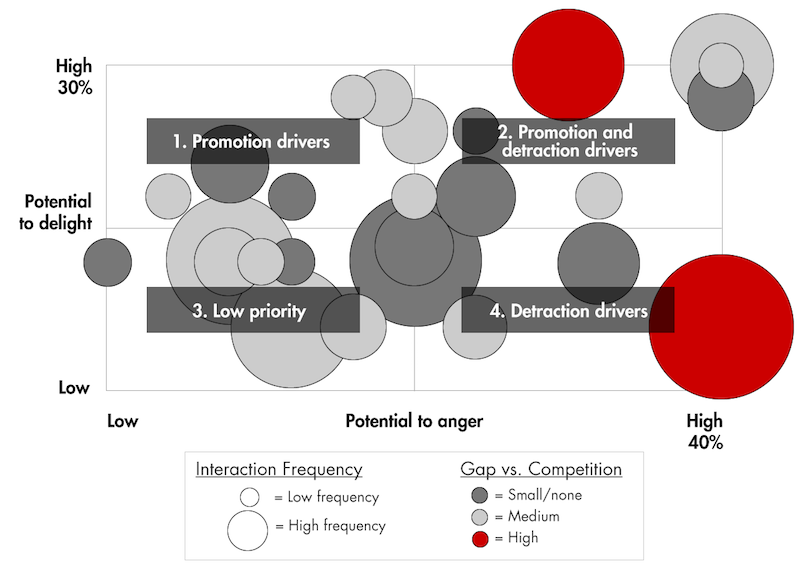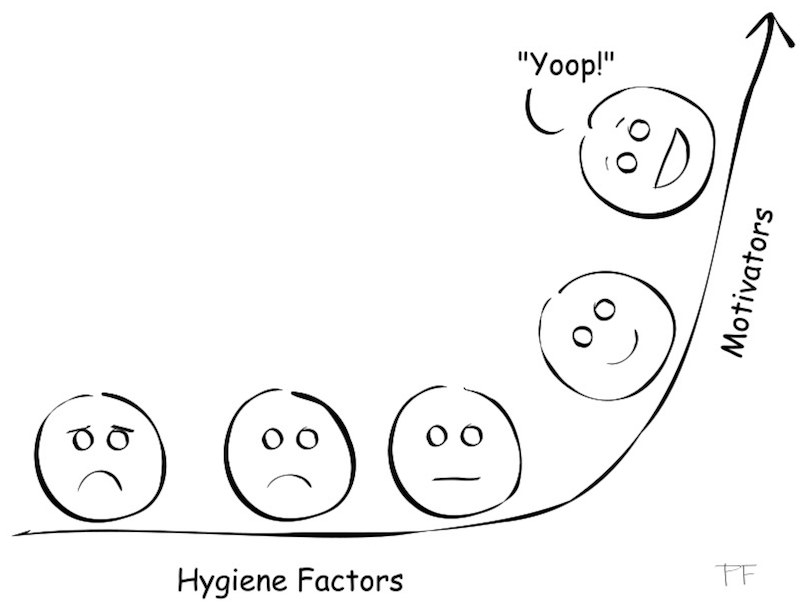‘Hygiene factors’ and ‘Motivators’ in customer experience – The Bain Anger-Delight Matrix
American psychologist Frederick Herzberg invented the ‘Two-factor Theory of Motivation‘ in the context of his work on how to motivate employees to perform. The two factors are ‘hygiene factors’ and ‘motivators’. I believe the theory also applies to customer behavior. Herzberg’s work is far simpler than Maslow’s and is easy to understand:
Hygiene factors
These are things like being paid enough to live on, general working conditions, job security, company policies and procedures, relationships with colleagues, a reasonably work-life balance, and good supervision. Once they are in place, the result is what I would call a ‘lack of dissatisfaction’. When the hygiene factors are all in place, a basic level of job performance and competence will be the norm. However, adding more of them does not achieve anything. If you are already satisfied with the comfort of your office chair, giving you a more comfortable one will not improve your performance. The same applies to things like your office PC. Once you are not unhappy, that is good enough.
Motivators
Things like challenging work, a sense of achievement, promotion opportunities and recognition fall into the category of motivators. The more they are present, the higher the productivity and achievement of the employees. In this category, the more you add, the better the performance. However, it is possible to destroy the motivation if the hygiene factors are not in place. Employees will be motivated, but will have a lot of complaints. Absence of the motivators returns employees to a basic level of performance, but has no ability to dissatisfy them.
Controversial
I have to say that Herzberg’s work is somewhat controversial. Many people disagree with it. I think the illustration below captures one of the objections, which is that there are hygiene factors that can indeed provide positive motivation, at least in extreme cases. OK, so maybe an extremely nice office chair can be a motivator.

Relationship with customer experience
Jim Dixon of Bain has done a great job translating Herzberg’s work into the world of customer experience. I have to say I am not sure it was his intention, but that is certainly the result. He refers to it as the Anger-Delight matrix, seen below.

The question, naturally, is how to determine which things fall into which category. The answers is: ask your customers. To really learn, you need to ask open questions. If you decide that you know all potential factors and ask customers to rate each one on a long list, you will have two problems. First, you may miss some important items. Second, you are presenting them to the customer as all being equally important, and they are not. A far better approach is to categorize your customers by level of happiness, and read and group their answers to the question about why they gave their rating. If you use NPS, you should expect the things Detractors mention to be biased towards the ‘Anger’ category. The same would apply to the people who give you the lowest scores on a CSAT scale. Customer Effort Score research tends to mainly capture ‘Anger’ items. Absence of significant effort is not usually a motivator.
Jim Dixon adds an important element, which is the comparison with your competitors, as shown by the red circles above. As always when communicating anything with red status, it is important to show very few of them. The red items represent the investment proposals.
Conclusion
Herzberg’s two-factor theory of motivation sacrifices the accuracy of Maslow’s theory for ease of communication. Even though Maslow only used five levels of motivators, few people can remember all five without assistance. Both the hygiene / motivator and the anger /delight models are easy to remember and to communicate. Definitely worth trying. As always, your comments and suggestions are welcome below.
Maurice



